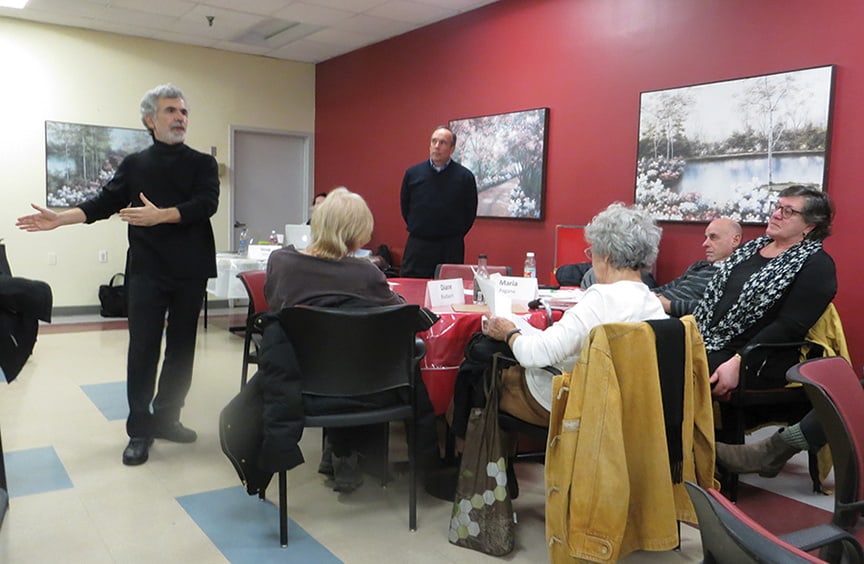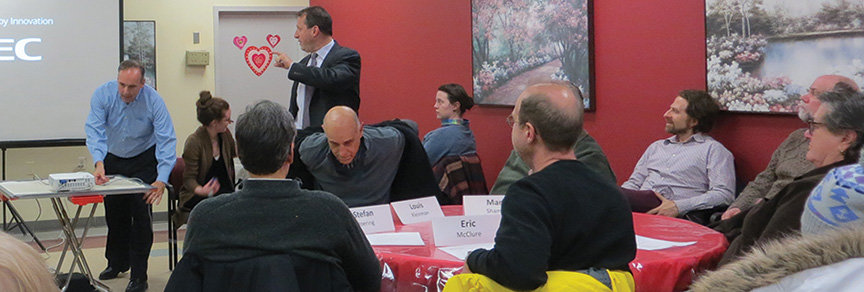It’s been a rough winter for meetings, as the weather has cancelled quite a few, including the January meeting of the Gowanus Community Advisory Group (CAG). The CAG serves as a conduit between the community and the EPA and was set up to monitor the Superfund cleanup of the Gowanus Canal.

The January meeting was held February 10 and featured an update of the project from Chief Engineer Christos Tsiamis. The group hadn’t met since November, so there was a lot to tell.
“We are exactly where we want to be – on schedule with the work,” Tsiamis told the audience of CAG members and guests which included representatives from public utilities and elected officials.
“Crews are already working in the canal,” continued Tsiamis. He explained that the current work involves testing various substrates to help decide the composition of the surface that will cover the bottom of the canal after dredging. That cover will prevent toxic chemicals from leaching upwards and re-contaminate the cleaned water. Tidal currents are also being mapped.
He complimented National Grid as well as local businesses that abut the canal for their cooperation.
Ferrara Brothers, the concrete company that still operates on the Public Place sight, agreed to clear off part of their workspace to accommodate staging operations of the testers. A floating dock will be installed which will be used by barges bringing materials.
Tsiamis even brought some good news relating to NYC. The city has been ordered to build two large holding tanks that will prevent sewage from being flushed into the canal during rain events, as is done currently. Originally, the city was supposed to proved the EPA with the two locations last summer – they now promise to make their final selection by the end of June.
The city has been reticent at first due to the expense and then because of community concerns about having to close Double D park at Degraw Street to place one of the tanks there. Tsiamis said that at recent talks with a whole roomful of city bureaucrats he was told that the decision could come before the end of June. When pressed by someone in the audience, he admitted that it could come a week before – he had no idea, actually.
He explained that when the dredging work finally begins, it will start at the 7th Street Basin and work south. For now, the testing work is being done at the 4th Street Basin, close to Whole Foods. Tsiamis said that was an ideal place to try out the techniques that will be used, as it is far enough from any residences so as not to disturb anyone.
Payment negotiations
Brian Carr, the legal expert on the EPA team, spoke of the money situation. The cost of the cleanup, estimated to be about $500 million, is borne by what are called Potentially Responsible Parties (PRPs). Many like to think that taxpayer money is spent by the EPA to clean up toxic sites, but this is untrue. Lawyers for all the PRP’s, which include the City of NY and National Grid, have been haggling over who will pay what – Carr said that he expects everything to be settled by September. A PRP that some may remember is Chemtura, who operated plants at the end of Court Street. In addition to polluting the Gowanus, the chemical company was also found liable for contaminating the Red Hook ballfields with PCB’s and other toxins.
At the end of the meeting, the CAG voted to admit five new members – all of whom reside in nearby Gowanus Public Housing.

Bridging Gowanus recap
The regular February meeting was held on the 24th. Brad Lander, freshly back from a City Council excursion to Israel, presented results from his Bridging Gowanus project.
Bridging Gowanus was a series of public meetings that followed a stakeholder meeting in which the future of Gowanus was discussed. In some ways it resembles a 197A plan, except instead of being sponsored by a community board, it is a politically driven plan, shepherded by Pratt Institute.
The work on the plan is complete, and available for viewing at www.bridginggowanus.com. Lander often speaks of trade-offs – meaning that for the community to ‘get’ something, it might have to give up something.
Some CAG members were critical of the plan. It acknowledges and seems not to challenge new residential developments, saying: “Where new housing is allowed in areas currently zoned for manufacturing, or where increased density might be allowed, developers should be required to include affordable units.”
CAG member Bette Stoltz wondered how existing infrastructure could support an increased population. Lander reminded all that there is currently a public comment period, that being the appropriate place to air complaints.
Following Lander was John Vetter, an EPA consultant whose specialty is archeology and historic preservation. He came seeking volunteers to serve on a consulting group under Section 106 of the National Historic Preservation Act.
That section mandates the Federal Government to be mindful of historically significant properties when performing things such as Superfund cleanups or building a federal building.
Vetter cited the bulkheads as a major example of Gowanus Canal history. Some bulkheads go back to the 1850’s, and are historically significant.
The Consulting Party Group would ensure that all bulkheads would be well documented, especially in cases where they will need to be replaced.
The Gowanus CAG meets monthly on the fourth Tuesday of each month. Meetings are usually held at St. Mary’s Star of the Sea, 41 First Street.








